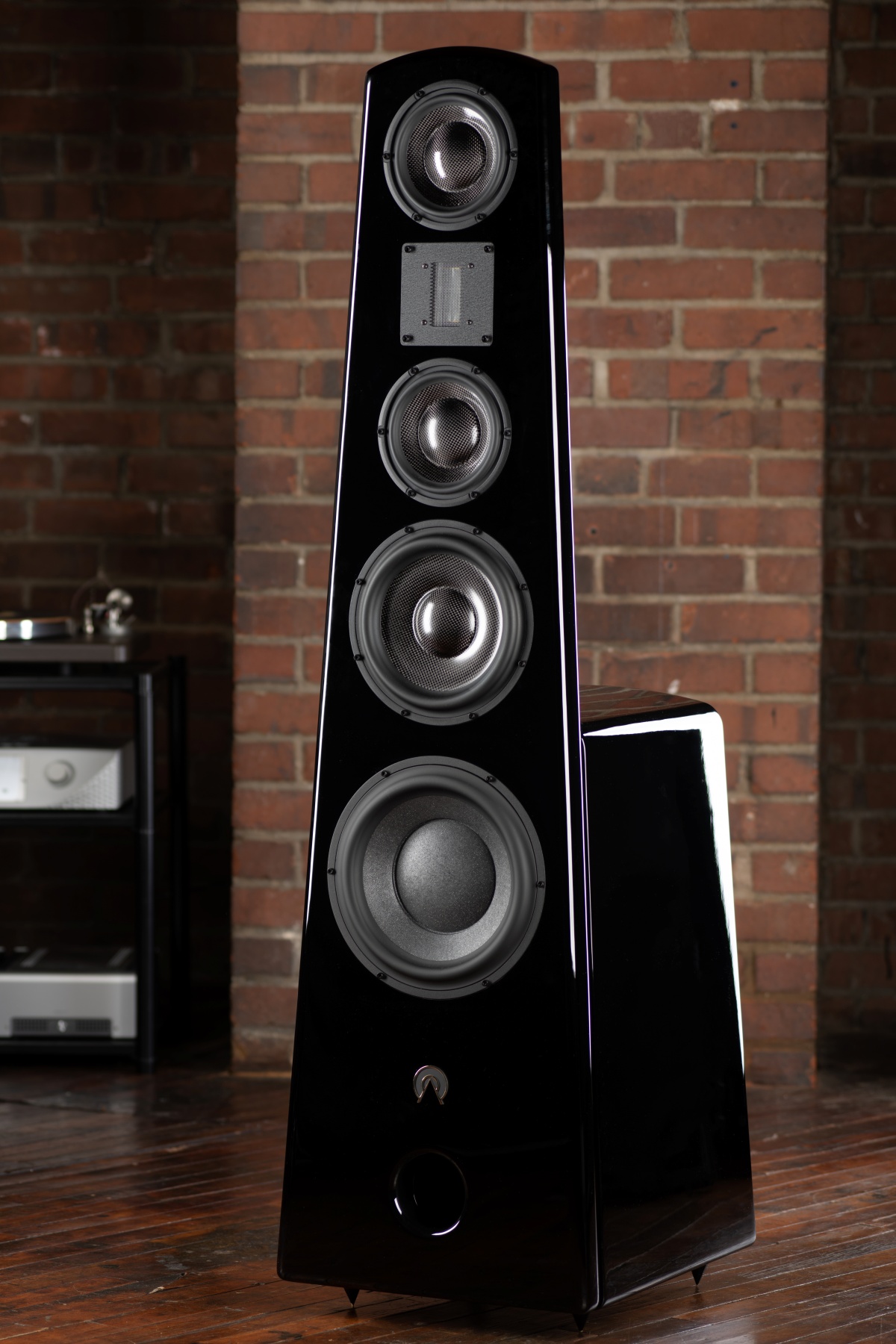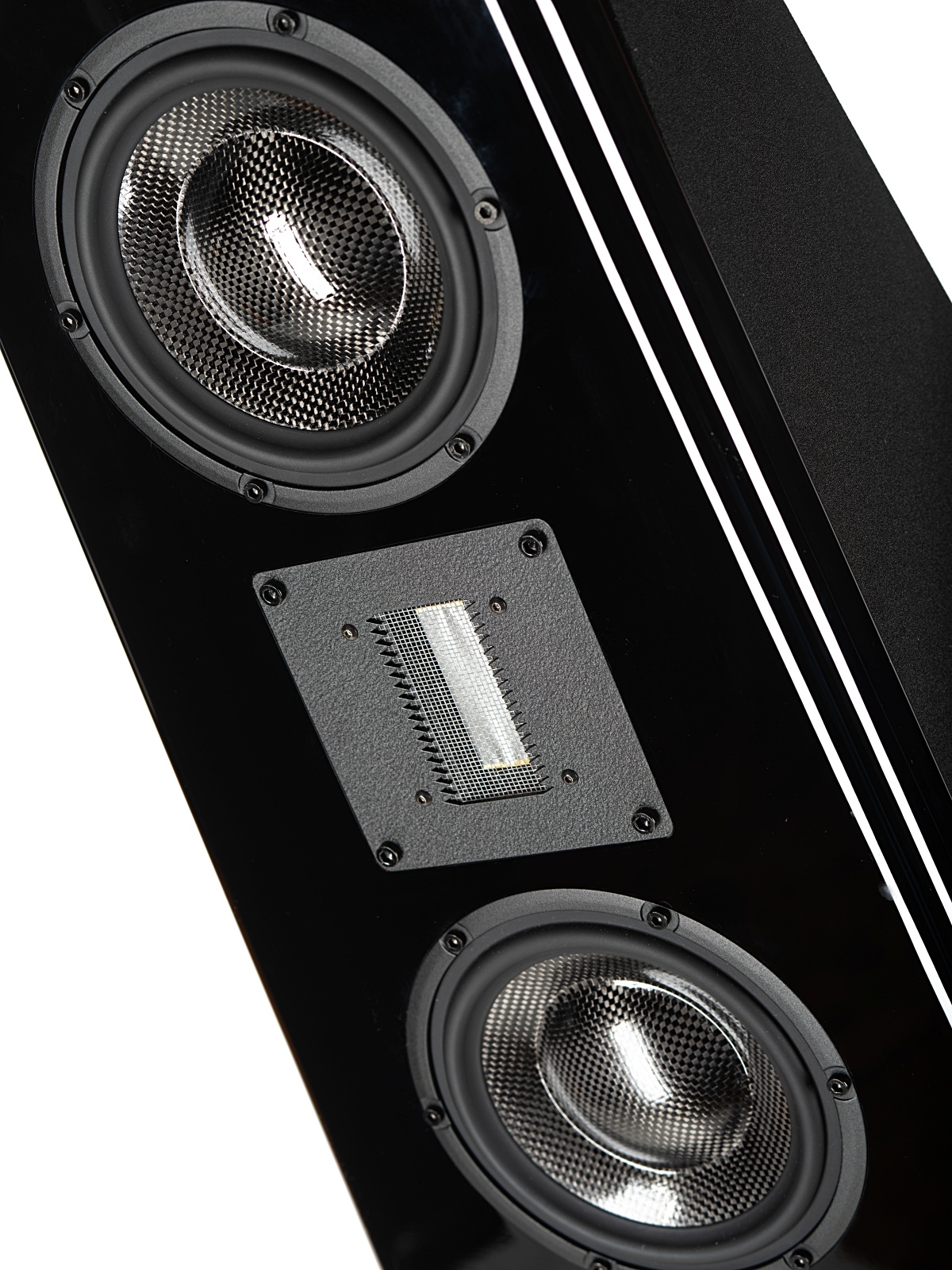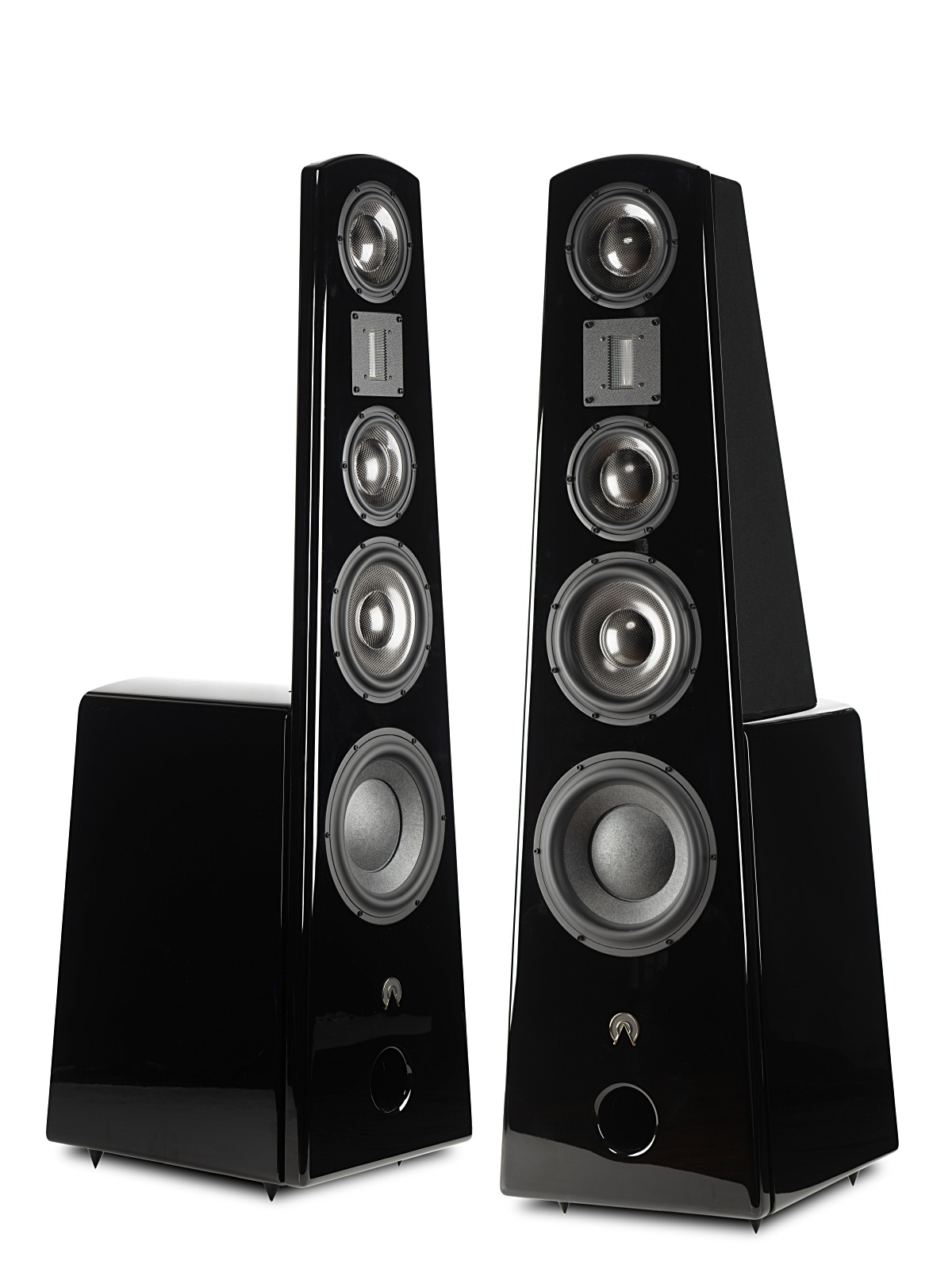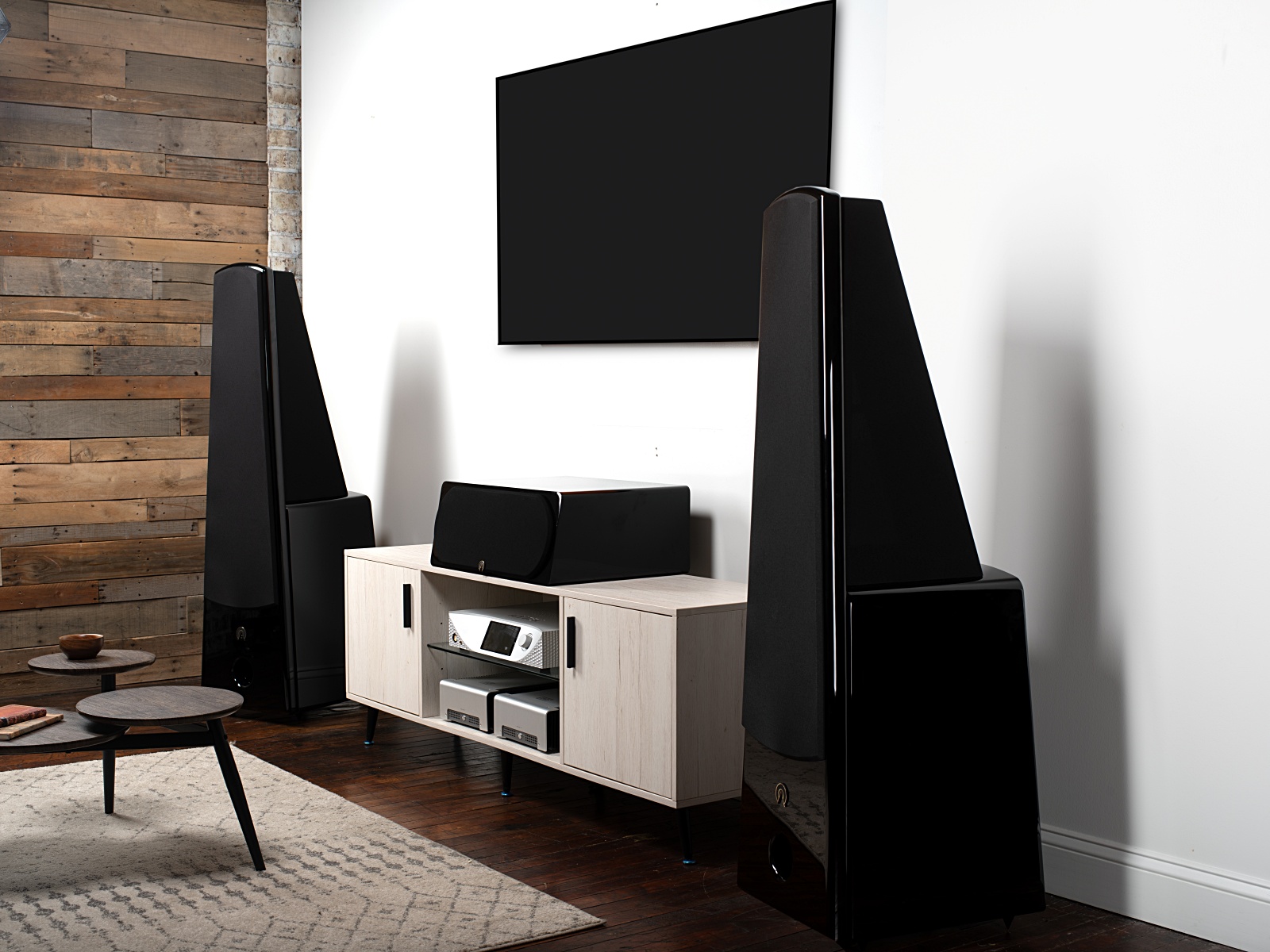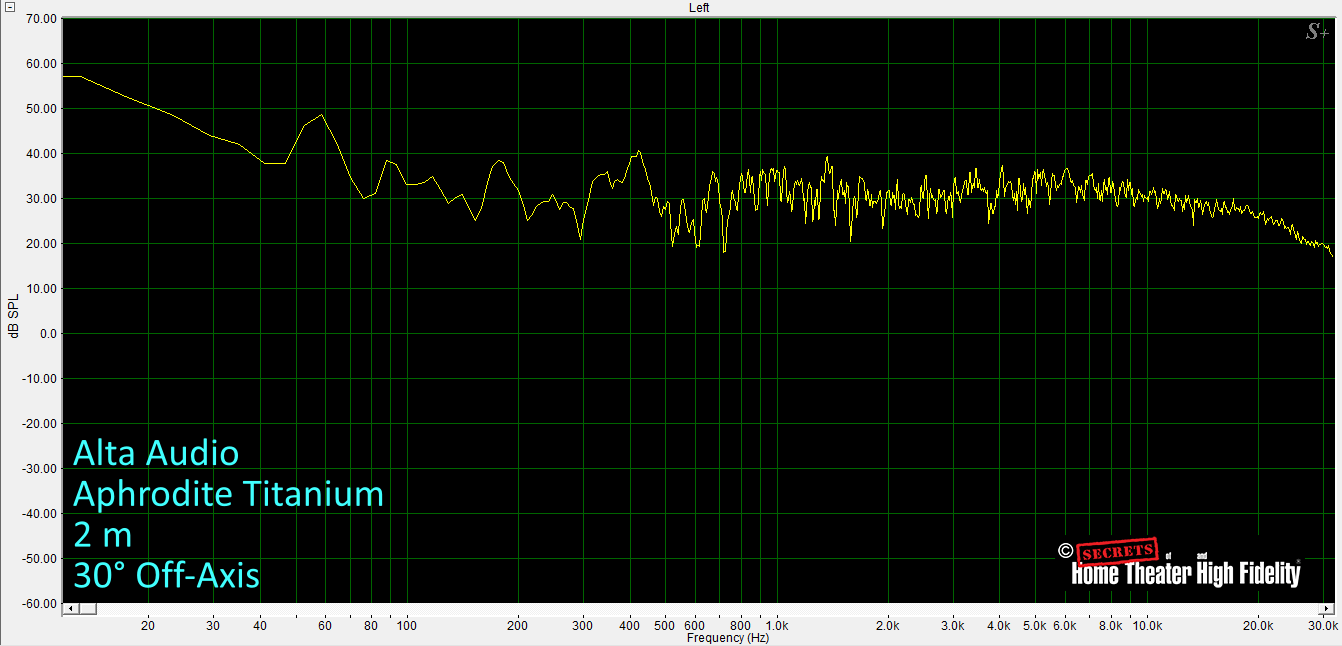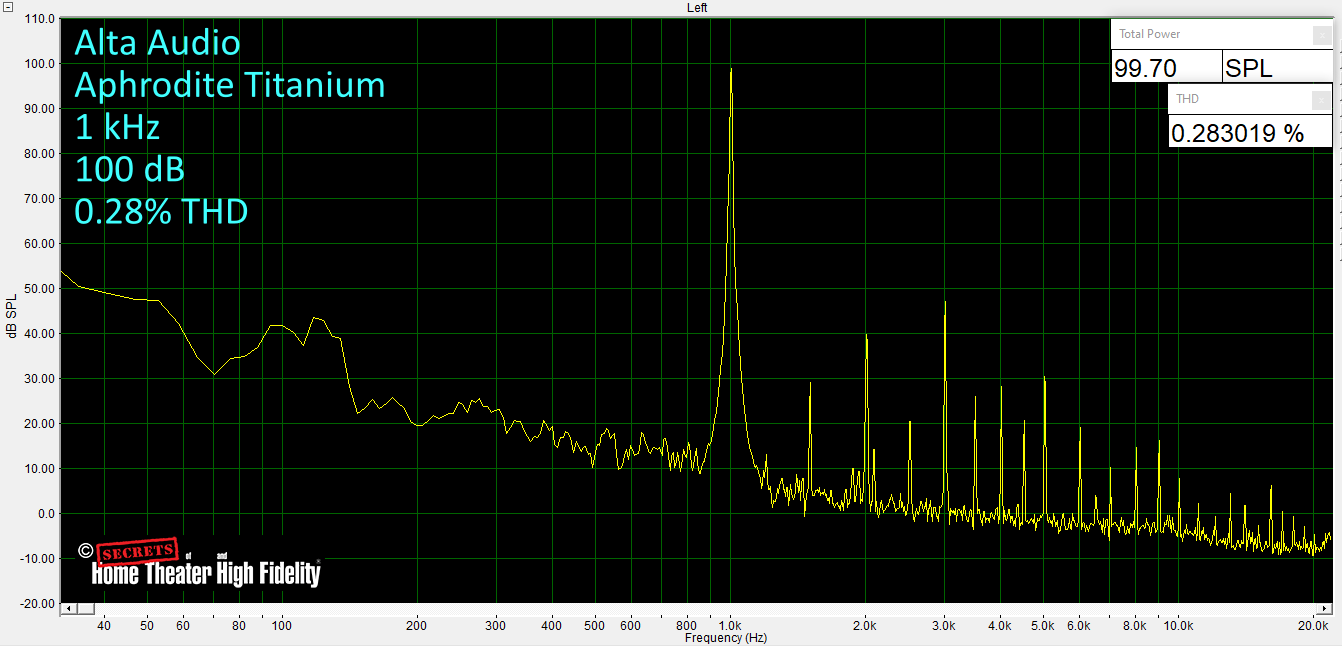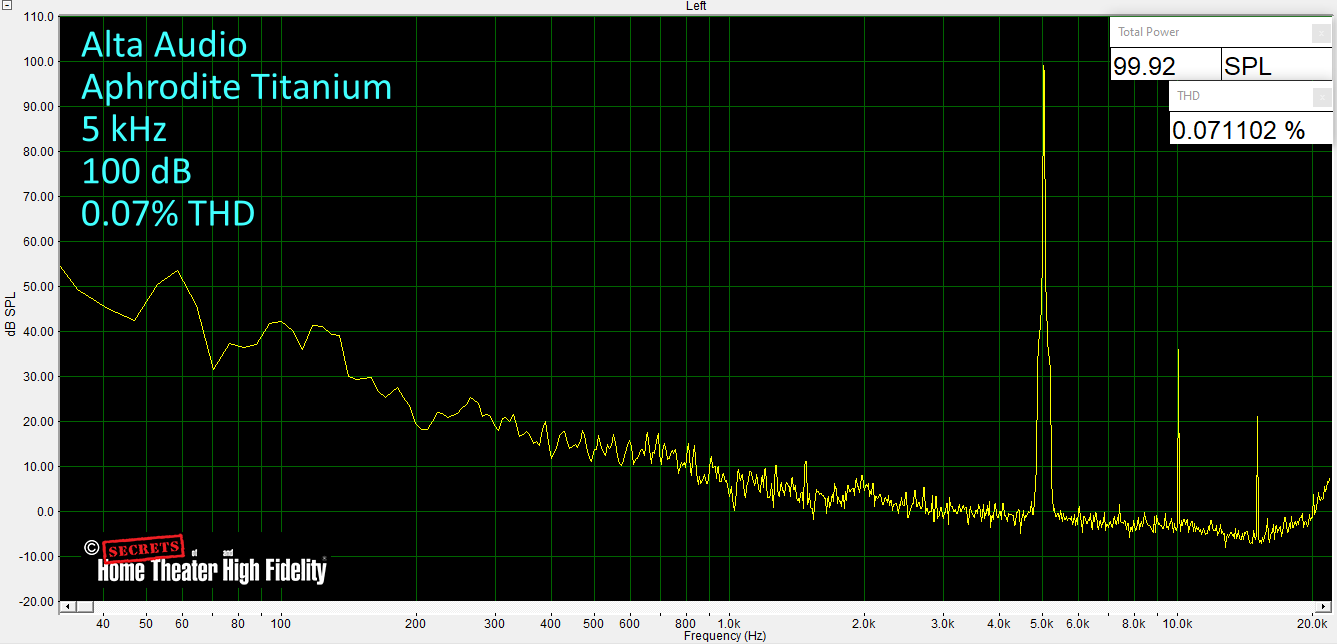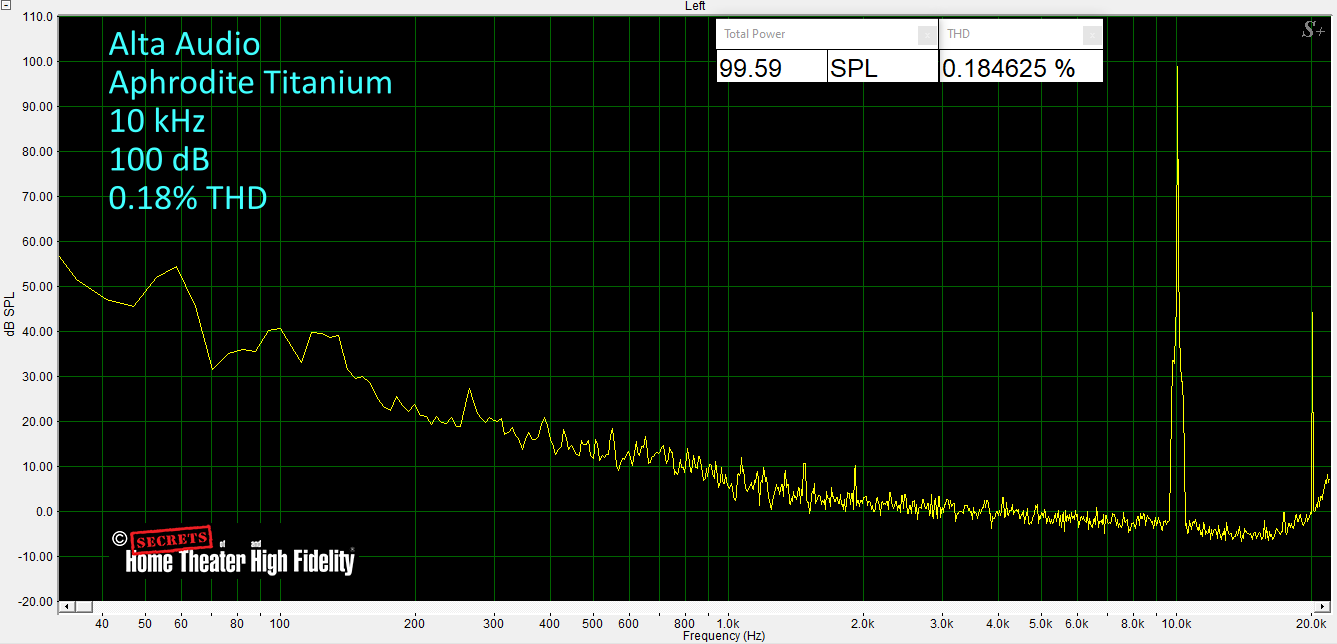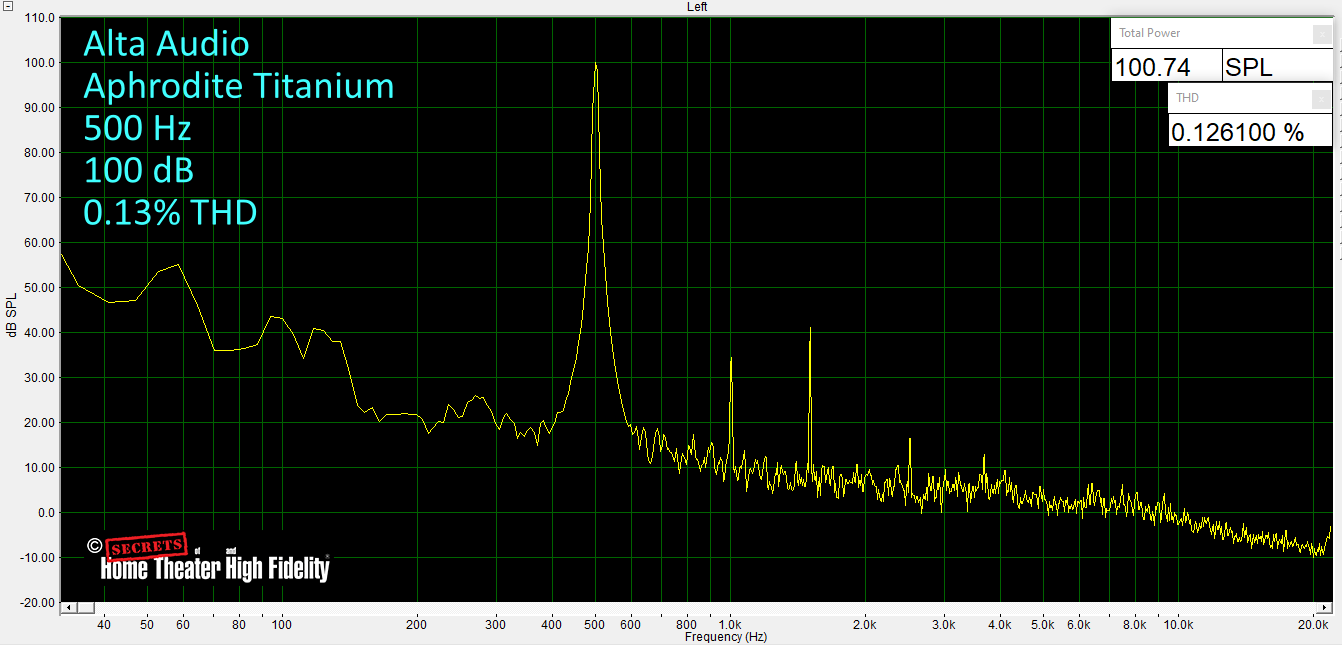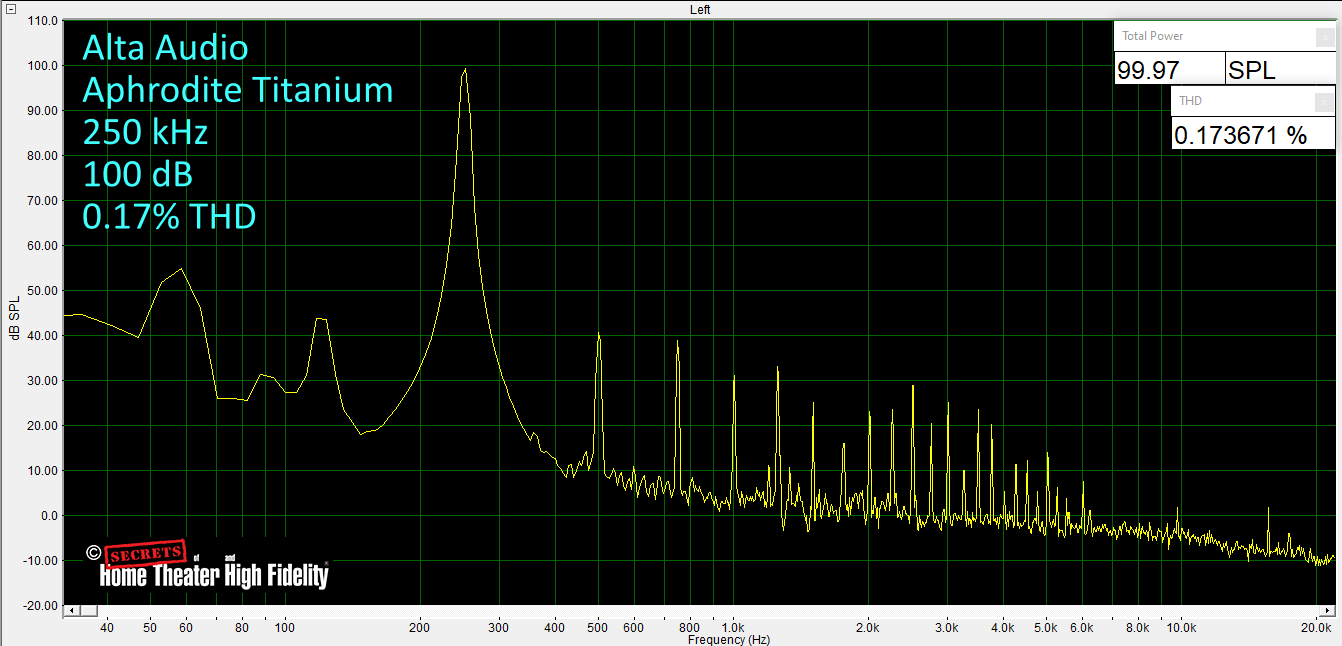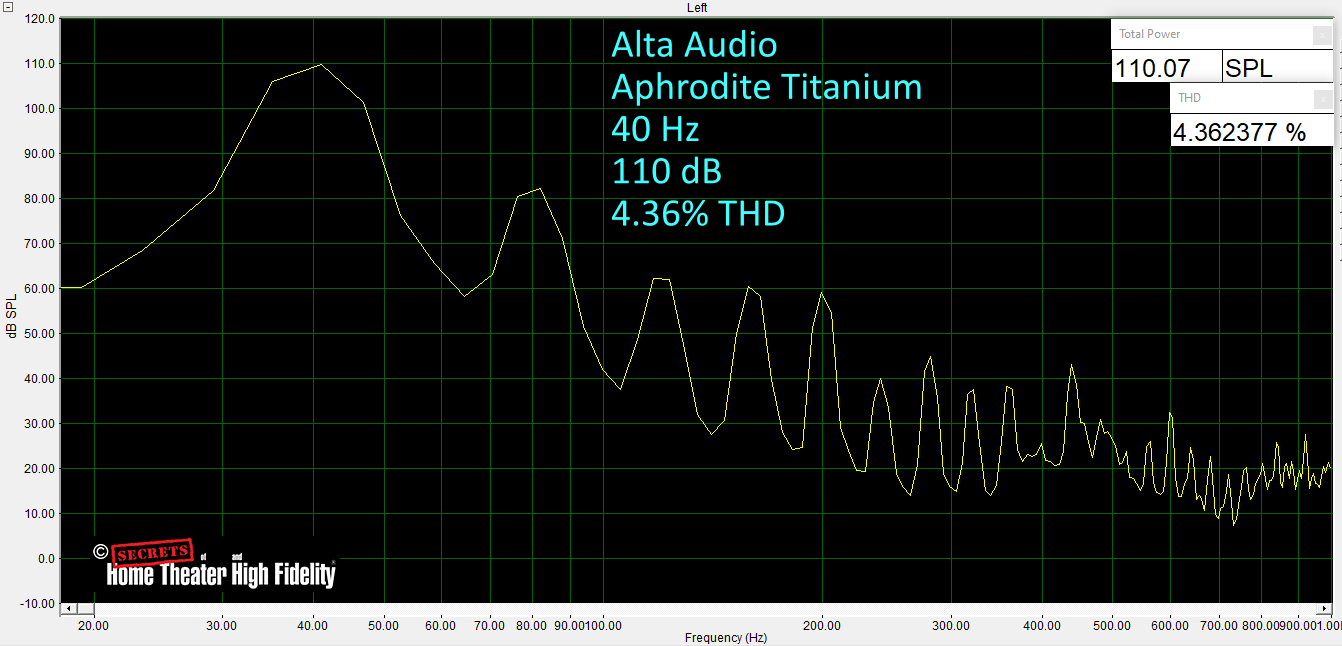These large, floor-standing speakers are legitimate full-range transducers that have a fun and agile sound that will get you up out of your chair whenever the beat hits just right. These speakers are also equally impressive in a home theater environment with excellent bass response and some of the best tweeters on the planet!
I felt like I was listening to one of those million-dollar systems when I first fired up the Alta Audio Aphrodite Titanium speakers. They impressed me throughout my extended auditioning period; singing with the strength of some of the best drivers available starting with the tweeters and ending with the specially-loaded subwoofers. The overall package was eminently entertaining every time I fired them up. They are not inexpensive speakers, but their performance was up to the task in almost every way. My only (minor) criticism was that I sometimes felt that these speakers didn’t always present music as a seamless whole.
Alta Audio Aphrodite Titanium Floor-Standing Loudspeakers
- Beautiful cabinet design and finish.
- Top-quality components.
- No need for a subwoofer because of the speakers’ inherent bass response.
- Excellent tweeters.
- Midrange and lower mid speakers in a dipole configuration.
- The Aphrodite Titanium speakers have a very high boogie factor.
- These Alta Audio speakers illuminated the sound so much, it was like seeing more stars in the sky.
- Could benefit from improved coherence.
I hate to admit it, but I have not gotten much prior exposure to speakers from Alta Audio. That is a shame because they have been around for many years, producing amazing speakers for home audio enthusiasts. My lack of familiarity with the brand all changed a few months back when I got an email from our Editor-in-Chief, Carlo Lo Raso asking if I would be interested in reviewing Alta Audio’s all-new flagship tower speakers, the Aphrodite Titaniums. I spent all of sixty seconds reading up on these speakers before I replied with a hearty, “Hell yeah!!!”
First of all, these speakers are a tour de force and the price is reflective of the design, refinement, and manufacturing of these really incredible speakers. I will describe the design in greater detail below, but the highlights are a 4-way, 5-driver hybrid open baffle/boxed woofer speaker that also features one hell of a ribbon tweeter.
These speakers are large and in charge, so I would definitely recommend you consider them only if you have the space to really let them sing. If you have the space (and the bread), then I would definitely recommend giving these a thorough audition. You might wind up bringing a pair home with you!
Design:
5-Driver, 4-Way Floor-Standing Speakers
MFR:
22 Hz – 47 kHz +/-3 dB
Tweeter:
1 ~ Amorphous Core High Output Ribbon Tweeter
Upper Midrange Drivers:
2 ~ 6″ Hex Cone with Titanium Former
Mid Bass Driver:
1 ~ 9″ Hex Cone with Titanium Former
Woofer:
1 ~ 10″ in Alta XTL Bass Tuning with Titanium Former
Loading:
XTL Bass Tuning
Crossover Frequencies (Hz):
Not Stated
Sensitivity (2.83V @ 1 m):
90 dB
Nominal Impedance:
4 Ohm
Recommended Amplifier Power:
50 W – 400 W
Weight:
137 lbs each
Maximum Dimensions (HxWxD):
54″ x 15″ x 18″
Available Finishes:
Gloss Black
MSRP (Each):
$25,000 ea. (USD)
Website:
Company:
SECRETS Tags:
Alta Audio, loudspeaker, floor standing, tower, ribbon tweeter, titanium former, Hex Cone, D’Appolito design, DampHard, XTL Bass, dipole
Secrets Sponsor
These speakers turned out to be much larger than I expected. I’m not sure what I was thinking, though, because the Alta Audio Aphrodite Titaniums have a lot of drivers in each cabinet.
Let’s work our way down from the top, shall we? The treble and upper midrange are supplied by way of three drivers in a D’Appolito array. For those unfamiliar with this concept, it is a tweeter between two midrange drivers, arranged vertically. The spacing of the drivers is key and is related to the crossover frequency. When done correctly, a D’Appolito configuration creates a unified wideband pulse response that closely mimics the original sound pulse. In the Aphrodite Titanium, there are two 6-inch midranges, one above and one below the ribbon tweeter in the crossover passband with the tweeter, thus creating a unified pulse.
The tweeters in these speakers are quite possibly the best tweeters I have ever had or heard in my home. They are specially-designed ribbon tweeters and I think Alta Audio might agree with me as this is how they describe the tweeters in their brochure, “By far the best tweeter we have ever tested. It is custom-built to our specifications, and its clarity and dynamics are unmatched. The Titanium Aphrodite centers this exceptional ribbon tweeter between the midranges creating a unified pulse and extending the high-end over an octave above the scope of human hearing.
- Custom-designed ribbon tweeter
- Powerful high-control magnetics
- State of the art Amorphous core transformer
- Extremely clear, fast, flat high-end response
- Extended response of over an octave above the scope of human hearing
The tweeters came with a protective cover for shipping. It was magnetic and I can tell you it was rather difficult to remove because of the very strong magnet in the tweeter.
The upper midrange drivers are 6″ cones. The cones are made from Carbon fiber/Rohacell composite, a very stiff and lightweight material. Also from the product brochure, additional features of the midrange drivers are:
- 3.1′′ Large HexatechTM Aluminum underhung VC
- Titanium coil bobbin
- Hybrid™ Neodymium/Ferrite magnet system
- Uniflow™ Aluminum diecast chassis
- High power handling
- Wide range of operation
Alta Audio calls the mid-bass driver a “Lower Midrange Coupler”. It is the same design and construction as the 6″ midrange drivers, only it has a 9″ nominal diameter. This driver is presumably added to enhance the transition from the upper mid-range to the low bass. It is a smart design because subwoofer drivers tend to be heavy and slow because of their low free-air resonance. This driver, by comparison, is much lighter and so would have a better transient response. This makes the bass much “tighter” than if all those frequencies were sent to the low-bass driver.
Speaking of bass, the Aphrodites feature proprietary 10″ bass drivers. They are loaded in a sort of hybrid transmission line/bass reflex enclosure that Alta Audio refers to as “XTL Bass”. The bass loading is patented and claimed to tune the bass similar to the way one would tune a musical instrument. They claim that this loading provides fast, extended bass. I can attest to this after my extensive listening sessions.
There are other design innovations at hand:
The upper and lower mids are mounted in an open baffle. The tweeter, by its nature, is not bipolar which seemed like that would be problematic in practice, but I never heard anything that would be considered an artifact of this reality. As a matter of fact, Alta Audio acknowledges this “discrepancy” and makes the claim that it is, in fact, a feature, I quote, “Blending in the pinpoint accuracy of the monopole ribbon tweeter keeps the individual images from becoming diffuse or bloated and lays them out realistically on the sound stage.”
All the cone drivers use titanium formers. The added stiffness of the titanium paves the way for larger-diameter voice coils; 3.1″ for the 6″ drivers and 5.1″ for the woofer voice coils.
The cabinets are constructed of a material they call “DampHard”. It is a multi-layered laminate material. The claim is that this material has superior dampening qualities, so very little internal padding is required to dampen the unwanted internal resonances. The idea is that reducing the batting in the speaker leads to faster and less muddy bass. Furthermore, the material has superior resonance control of the cabinet itself, so the end user enjoys a sound free of unwanted cabinet resonances.
Whew, that’s a lot of technology in there! I’m sure the somewhat high price of these speakers is indicative of all the R&D and materials technology implemented.
These are large and heavy speakers, so setup took a little longer than usual. I needed an extra set of hands to help unbox the speakers and wrestle them into their starting positions. Thankfully, the packaging was well thought out and wasn’t unduly hard to work with. I can’t say that about many large, boutique-type speakers I have reviewed.
I started with no floor spikes so I could shift them about and tune in the best spot and toe-in for each speaker. The fine people at Alta Audio were very helpful in guiding me in the setup and placement process. I am sure all their customers get the same kind of support from their dealer or Alta Audio, depending on the circumstances.
In the end, I wound up with the speakers farther from the front wall than usual, because this enhanced the speakers’ dipole nature. I also wound up with more toe-in than usual as I found this to provide the smoothest mid and treble response I could get.
The folks at Alta Audio intimated that the Aphrodite Titanium speakers are best when driven by a solid-state Class A amplifier. Fortunately, I had the perfect amplifier in-house, the Pass Labs INT-25. I also tested the Aphrodite Titanium speakers with a pair of D-Sonic 1,500 wpc monoblocks (Class D). For cinema use in a surround setting, I utilized an ATI 7-channel, 200 wpc amplifier.
Sources for two-channel listening were a MoFI Ultradeck turntable playing through a Pass Labs XP -17 phono stage. On the digital side, I either streamed off my PS Audi AirLens as a Roon endpoint or I played discs through my Oppo BDP 105D. Both of these digital sources were converted from digital by my Topping D90 DAC.
All cables are an assortment of Clarus Crimson, AudioQuest, Blue Jeans cables, and Monoprice.
Though I used these speakers predominately in two-channel mode for music, I did try them out in my home theater to start things off. I was a little surprised that they needed more gain than my reference speakers because the Aphrodite Titanium speakers have a higher sensitivity rating. I’m not sure what exactly is going on here, but it was not an issue in any way, just an immediate observation I made. I’m sure the loads of various speakers can affect the required gain, irrespective of the stated sensitivity.
My center channel speaker is a GoldenEar SuperCenter Reference speaker. This speaker has a ribbon tweeter. My main reference speakers are a pair of VIVD Kaya 90’s which have dome tweeters and, though the cinematic experience in my home theater is excellent, these speakers do not blend with the center’s ribbon tweeter as well as I would like. So, that was my first observation of the Aphrodite Titanium speaker – their amazing tweeters were a much better blend with the GoldenEar’s ribbon tweeters.
Another thing I tried at the urging of Alta Audio was enjoying movies with the main speakers set to “Large” and the subwoofer turned off. Though the Aphrodite Titanium speakers do not go as low as my SVS SB 16 Ultra subwoofer, they played plenty low enough for me and I got a very satisfying performance with no sub in play.
Now, let’s discuss the performance on two-channel with a tidy little Class A amplifier. Though the Pass Labs INT-25 is rated at 25 wpc, in my own independent testing, this sample produced 100 wpc into 4 Ohms at less than the rated distortion. So, I tell people that it is a “100-watt amplifier”. I mention this because earlier I noted how I needed more gain than usual to get the Aphrodite Titanium speakers to blend with my satellites on multi-channel, but there were no issues driving them with this smallish amplifier.
I’d like to start by saying that these speakers have some of the cleanest and most musical bass I have ever gotten in my system. My reference speakers are slightly cleaner-sounding and possibly a little tighter, but the Aphrodite Titanium speakers are equally as musical with much better extension. Also, they sing better with the Class A amplifier by a long shot.

Victoria Monét, “Jaguar”
I started off with a high-resolution streaming performance of Victoria Monét’s Jaguar EP. Released in 2020, this EP garnered Monét with high acclaim and she has subsequently been nominated for a whole slate of awards. She won three Grammy Awards in 2024: Best New Artist, Best R&B Album (Jaguar II), and Best Engineered Album (Non-Classical) also for Jaguar II.
On the Jaguar EP, the title track was a showcase of audiophile greatness. This applied to the rollicking bass lines, the upper treble, and everything in between. The horns and vocals really filled the room.
On “Experience”, there was an undue amount of reverb on the vocals but the speakers still maintained the delicate balance between focus and a wide stage. The Aphrodite Titanium speakers made it as if I were seeing more stars in the galaxy than with other speakers. It was reminiscent of hearing one of those $1M systems at a trade show or in some rich friend’s house!

Beastie Boys, “The In Sound from Way Out!”
Next up, I streamed a Beastie Boys Compilation of instrumentals from Check Your Head and Ill Communication. The album is entitled, The In Sound from Way Out! These are funky, jazzy tunes with a soul band’s heart. The album is like a throwback. Take “Namaste (Alternate Mix/No Vocals)” as an example. The funky groove of this track just washed over me, drawing me in.
Then Pow came along and blew it out of the box. We got up and started dancing, even when the tempo slowed. These Aphrodite Titanium speakers are excellent communicators and made everyone want to get on their feet to enjoy the groovy vibe on the record.

Paavo Jarvi, Tonhalle-Orchester Zurich (Zurich Symphony Orchestra), Anton Bruckner, “Bruckner: Symphony No. 7”
The last selection was CD-quality and I needed to test these speakers with some high-resolution streaming action. So, I queued up Bruckner Symphony No. 7 by the Zurich Symphony Orchestra conducted by Paavo Jarvi. This album was a standout in my auditioning as it was conveyed with so much care and respect for the source. It represented an excellent reproduction of a performance in my listening room.
However, it was also during this album that my listening notes took a different turn. Here is what I wrote, “I don’t have any direct criticism of these speakers other than to say that, at times, they were not as coherent as some of the other great speakers I have had in my system. These speakers clearly communicated all the notes as well as any speaker I have had in my system but some other speakers do a slightly better job of knitting it all together into a seamless whole. I still enjoyed every minute with the Aphrodite Titaniums and they were always ready to shine light on heretofore unheard or unrecognized details in some of my favorite music.” I am not sure why this was the case.

Katie Melua, “Ultimate Collection”
I love Roon for helping me find all kinds of music and musicians I would not have heard of otherwise. Also, I can’t wrap a review without diving into some excellent female vocals and how could I go wrong with Katie Melua’s Ultimate Collection? I was enraptured by each and every track on this incredible compilation. I could listen to this album on repeat all day long as she has such a lush and sultry vocal presentation and these speakers brought out the best in all of it.
These are not bass-heavy tracks, but the excellent bass response of the Aphrodite laid a remarkable foundation for all the other sounds. I can feel the bass throughout my body, even with this “little 25 wpc” amplifier. A friend of mine lost a loved one recently and this music especially touched me while reflecting on his loss. So, that’s what I ultimately loved about these speakers – they communicate the soul in the music and touch you emotionally. I mean, my eyes were glazed over and I could barely write this.
“Just Like Heaven” is a great example of a track that really touched me. It was a musical masterclass and I concluded that these speakers are legit right then and there. The staging, the focus, the bass response, the midrange transparency and detail, the ability to sort the most complex passages, and the broad power response throughout my room, maybe the best tweeters I have ever heard, and they look pretty cool too. It all came together on “Fields of Gold” where my notes simply stated “Omfg”.
Secrets Sponsor
I have been bench-testing speakers in my listening room for approximately 15 years. I have done my best to be consistent with the placement of the speakers in the room as well as being consistent with the testing methodology employed over the years. This is mainly because my tests are affected by room modes and other interactions, so you can’t compare my tests to those done in an anechoic chamber or even ground plane tests for that matter. But, my thought was if I stay consistent, then readers could at least compare the various results I have obtained to get a good handle on the relative performance of speakers that I have personally tested and reviewed in my home.
All of that will be changing now, unfortunately. We are planning to move out of state, so I will have an all-new room and the process will begin anew. Also, the test results I obtained with the Alta Audio Aphrodite Titanium speakers were affected by our move. You see, we had already begun packing up when I ran the below tests. The existence of numerous moving boxes meant that I could not place the speakers in the usual spot for testing. Also, the speakers have been returned, and I failed to save my on-axis frequency response tests and so I am not able to publish it. In any event, the test results from the Alta Audio Aphrodite Titaniums were nevertheless quite impressive.
The first plot below is the white noise test I ran with the mic 2 meters from the tweeter.
This 30° off-axis test shows a response that was indeed affected by room modes and I cannot make any representation as to how accurate the readout is due to the unusual speaker placement. What you do see is that the response is very smooth above the frequencies typically affected by room modes, with flat treble extension to about 18 kHz and then dropping in output smoothly to 30 kHz, the limit of the test plot. This may not seem great, but it really is as few tweeters I have tested extend all the way to 20 kHz regardless of the speaker price or technology.
The next set of plots are the basic THD tests I run with the mic tip 1m (3′-4″) from the driver under test. I ran the tests at 100 dB.
At 1 kHz and 100 dB, the THD was 0.28%. I also ran this test at 90 dB (not shown) and the resultant THD was 0.06%!)
Moving up the audio band, I ran a 100 dB THD test at 5 kHz. This was from the ribbon tweeter. The distortion readout was another inaudible result of only 0.07%!
The next test was a 10 kHz sine wave at 100 dB. The distortion was a little higher measuring an extremely low THD of 0.18%. (At 90 dB the THD was only 0.06%.)
Moving down the scale, the 100 dB test at 500 Hz yields a THD of 0.13%. (0.07% at 90 dB)
At 250 Hz and 100 dB, the THD was still incredibly low at 0.17%. This was from the mid-woofer.
This was a bass torture test. I ran the test at 40 Hz with the idea I could find the point where the THD hit 10% as this is considered the threshold of audibility for bass distortion. I stopped testing at 110 dB because the house was already shaking. I can attest this is louder than I would actually ever listen to music and about as high as I would reach on a movie soundtrack. The measured THD at the high output level was 4.36%.
The Alta Audio Aphrodite Titanium speakers impressed me every time I turned on the system for a listening session. Whether I was listening to music or watching a movie, these speakers provided a full-range listening experience that was always fun and entertaining.
- Excellent build quality
- Unique design
- Amazing tweeters
- Decidedly full-range sound reproduction
- They get you up out of your chair for impromptu dancing
- Luminous soundstage
- Improve the last iota of coherence in the sound
- More color options (besides gloss black)
I hope Alta Audio is suitably proud of its new flagship speakers. The reason I say this is because these speakers are among the top three speakers I have reviewed in my home. That is saying something as I have reviewed several high-end speakers, some of which tend to garner a lot of universal acclaim. But, in many ways, these other speakers were bested by the Aphrodite Titaniums. It’s a shame, really, since Alta Audio deserves more industry-wide recognition than they have previously received at least based on my personal experiences in this instance.
I found these to be well-made and thoughtfully designed loudspeakers with a unique approach to their development and implementation. The result is a relatively expensive pair of large tower speakers that can command a big room, but will also play with subtlety and nuance when called upon. And, unlike many complex speaker designs, these babies have a high degree of boogie factor.
I did feel that at times the music didn’t always sound as if cut from whole cloth as one might say. However, that small bit of criticism did not detract from my overall enjoyment throughout a lengthy audition period. A great analogy is as if you were observing the galaxy with a small refractor telescope and then switching to looking through the James Webb Telescope. All of a sudden, you can see all the stars in all the colors and it can be so clear. That’s how I will compare the Alta Audio Aphrodite Titaniums to the majority of their competition. Heartily recommended.




